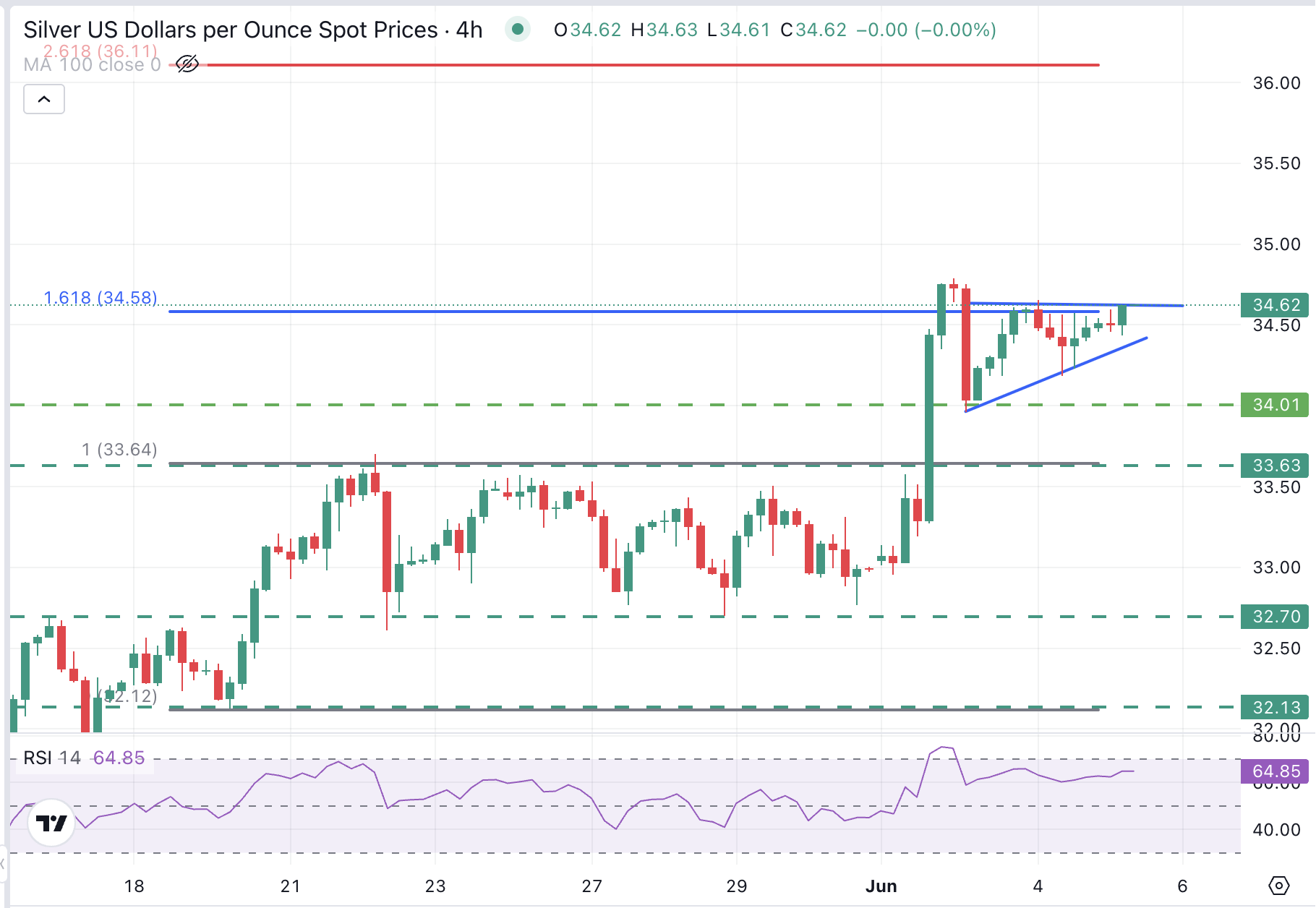Silver Price Forecast: XAG/USD remains positive, supported above $34.00
- Silver prices maintain their bid tone, favoured by a weak USD..
- Weak US services and employment figures boosted safe-haven demand on Wednesday.
- XAG/USD is moving within a small ascending triangle, a bullish sign.
Silver prices (XAG/USD) maintain their bullish structure intact, with bulls aiming for the $34.60-$34.80 resistance area, with downside attempts contained above the $34.00 support level.
A US Dollar on its back foot is contributing to keeping the precious metal buoyed. US ISM Services PMI data showed an unexpected contraction in the sector’s activity in May, and the ADP Employment report posted a poor increase in payrolls, which revived fears of an economic recession.
Beyond that, the global trade scenario remains highly uncertain. The negotiations between the US and its trade partners are failing to yield any significant breakthrough, and Trump has complained about the difficulties of cutting a deal with China’s President, Xi, revealing that the world’s two major economies are far from reaching a trade agreement.
XAG/USD is showing an ascending triangle pattern
The technical picture shows a bullish structure in place, from mid-May lows at $31.75, with price action testing the top of an ascending triangle pattern, which points to an eventual bullish outcome.
Prices are about to test the top of the triangle, at the lower limit of the $34.60-34-80 resistance area, which has been holding the pair over the last few days. Above here, a 261.8% Fibonacci extension awaits at the $36.10 area.
On the downside, a breach of $34.00 would invalidate this view, and add pressure towards the previous top, at $33.65 ahead of the $32.70 level.
XAG/USD 4-Hour Chart

Silver FAQs
Silver is a precious metal highly traded among investors. It has been historically used as a store of value and a medium of exchange. Although less popular than Gold, traders may turn to Silver to diversify their investment portfolio, for its intrinsic value or as a potential hedge during high-inflation periods. Investors can buy physical Silver, in coins or in bars, or trade it through vehicles such as Exchange Traded Funds, which track its price on international markets.
Silver prices can move due to a wide range of factors. Geopolitical instability or fears of a deep recession can make Silver price escalate due to its safe-haven status, although to a lesser extent than Gold's. As a yieldless asset, Silver tends to rise with lower interest rates. Its moves also depend on how the US Dollar (USD) behaves as the asset is priced in dollars (XAG/USD). A strong Dollar tends to keep the price of Silver at bay, whereas a weaker Dollar is likely to propel prices up. Other factors such as investment demand, mining supply – Silver is much more abundant than Gold – and recycling rates can also affect prices.
Silver is widely used in industry, particularly in sectors such as electronics or solar energy, as it has one of the highest electric conductivity of all metals – more than Copper and Gold. A surge in demand can increase prices, while a decline tends to lower them. Dynamics in the US, Chinese and Indian economies can also contribute to price swings: for the US and particularly China, their big industrial sectors use Silver in various processes; in India, consumers’ demand for the precious metal for jewellery also plays a key role in setting prices.
Silver prices tend to follow Gold's moves. When Gold prices rise, Silver typically follows suit, as their status as safe-haven assets is similar. The Gold/Silver ratio, which shows the number of ounces of Silver needed to equal the value of one ounce of Gold, may help to determine the relative valuation between both metals. Some investors may consider a high ratio as an indicator that Silver is undervalued, or Gold is overvalued. On the contrary, a low ratio might suggest that Gold is undervalued relative to Silver.

